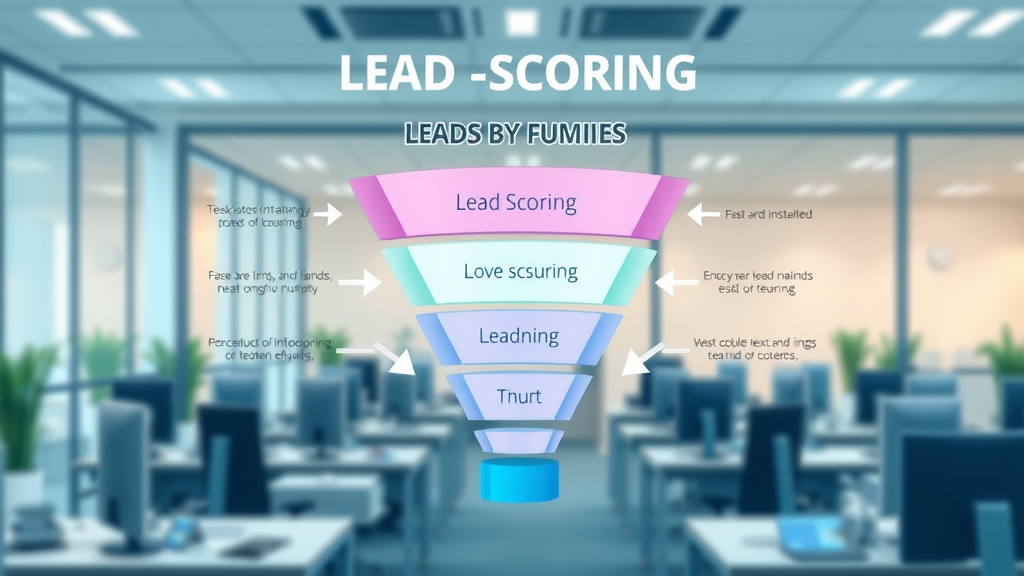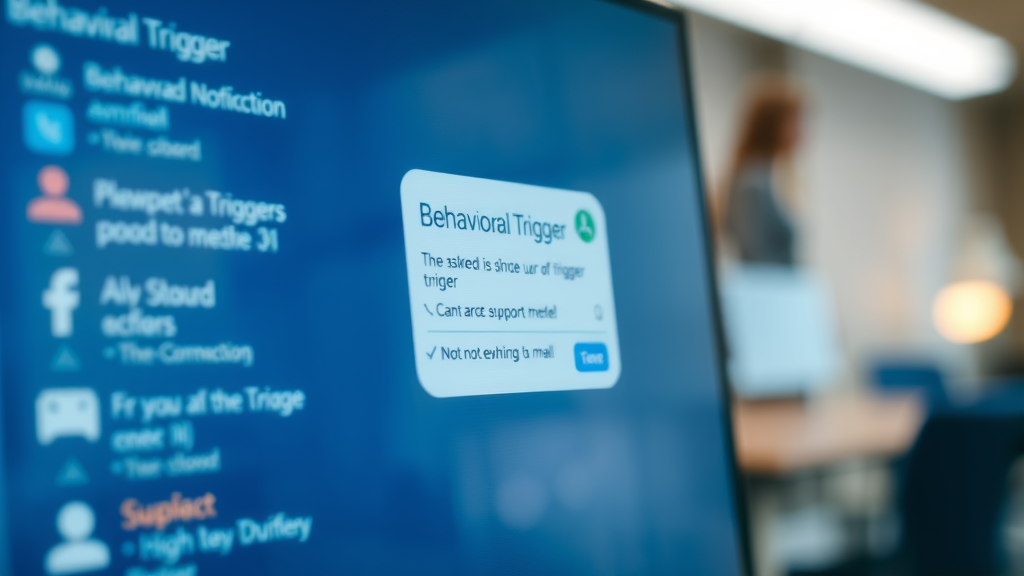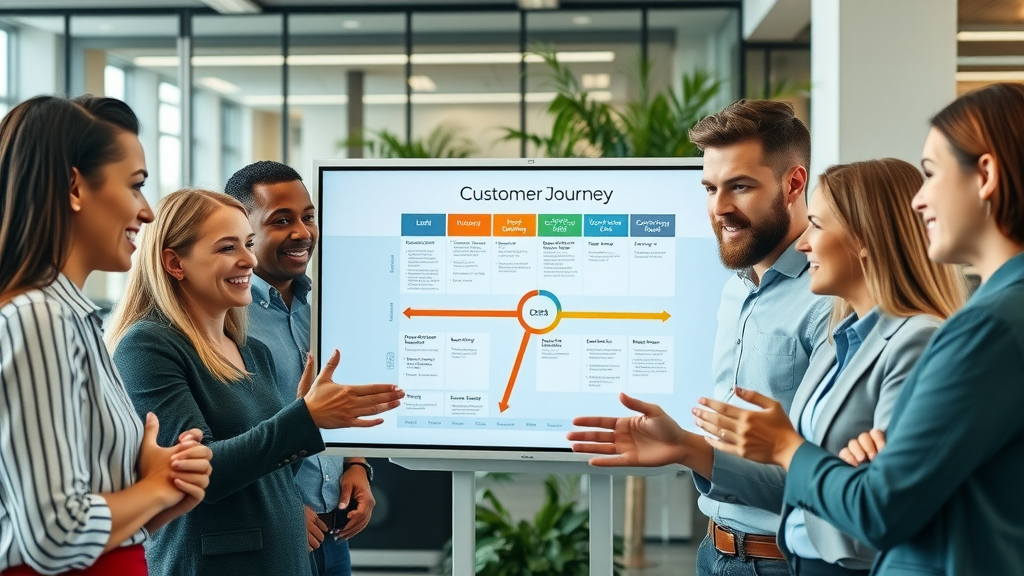Did you know? Robust lead scoring and qualification can boost your lead ROI by 77% and your conversion rate by 50% . Most sales teams leave untapped opportunities in their sales pipeline by relying on outdated approaches. In today’s crowded marketplace, the difference between hitting targets and struggling to survive often comes down to how you identify and prioritize leads. If you want your sales reps to focus on your highest potential customers—and drive results for your business—this guide will show you how to transform your approach to qualifying leads, step by step.
Unlocking Success with Lead Scoring and Qualification: Surprising Stats Every Sales Team Must Know
"According to recent studies, companies leveraging robust lead scoring and qualification strategies average a 77% increase in lead ROI and a 50% boost in conversion rate—can your business afford to miss out?"

- Why traditional lead qualification methods are leaving sales pipeline opportunities on the table
- How advanced lead scoring pinpoints high-value sales leads in today's crowded market
Sales teams face increasingly fierce competition and complex buying cycles. Relying solely on gut instinct or basic lead qualification can mean missing out on prime sales leads, wasting resources, and losing deals to more agile competitors. If you’re still treating all leads the same, your competitors are already steps ahead—harnessing lead scoring and qualification to streamline their sales funnel and maximize conversion rates.
Let’s explore how these strategies can revolutionize your next sales quarter and propel your team toward record-breaking results.
Defining Lead Scoring and Qualification: Core Principles That Drive High Conversion Rate
What Is Lead Scoring and How Does It Impact Lead Gen and Sales Funnel Optimization?

Lead scoring is the process of assigning a numerical value to each incoming sales lead based on specific criteria—like demographics , engagement behaviors , or fit with your company's ideal customer profile. These scores help sales reps and sales teams prioritize leads most likely to convert, ensuring valuable time and resources are allocated toward those who can drive the greatest returns.
In the age of big data and digital marketing, relying on automated lead scoring models—integrated into your CRM or sales technology—enables rapid, objective decision-making. It's not just about lead gen; it's about supercharging your sales funnel efficiency, elevating your conversion rates, and keeping your sales pipeline healthy. Optimized lead scoring systematically filters for high-quality leads, driving greater sales results while reducing wasted marketing efforts.
Lead Qualification: Filtering for Qualified Leads and High-Value Prospects
While lead scoring tells you who is hot, lead qualification determines whether a potential customer truly fits your product or service’s requirements. It’s the quality-control element of your sales process —a set of checks that ensures not only strong interest but also readiness, budget, need, and authority to buy.
"Not all leads are created equal—qualified leads are the engine of a high-performing sales team."
Leads based only on interest don’t always result in sales. To maximize sales pipeline conversion, sales teams must integrate a clear, documented lead qualification framework. This step transforms a list of prospects into a source of high-value, sales-ready opportunities and secures vital alignment between your marketing team and your sales reps. The result? A sharper focus on high-potential customers and less time wasted on unqualified prospects.
What You'll Learn in This Guide to Lead Scoring and Qualification
- The exact steps for effective lead scoring and qualification processes
- The criteria that separate a qualified lead from a cold prospect
- Proven lead scoring models that increase conversion rate
- How sales and marketing teams align on lead qualification
The Key Differences Between Lead Scoring and Qualification
People Also Ask: What is the difference between lead scoring and qualification?

Lead scoring quantitatively prioritizes leads by using data-driven points systems, whereas lead qualification assesses whether those leads are truly able and willing to buy. In brief, scoring answers “Who is warm ?” and qualifying answers, “Who can buy now and is the right fit?” Together, these processes eliminate guesswork, giving sales reps the information needed to focus their efforts on the most promising prospects.
A well-oiled sales pipeline combines both: scoring quickly sorts the influx of leads and qualifying then filters deeper to find top-quality leads. Understanding and communicating these distinctions empowers sales teams to optimize their sales efforts, maintain healthy pipelines, and maximize win rates.
Lead Scoring vs. Lead Qualification: Process, Purpose, and Areas of Alignment
| Criterion | Description |
|---|---|
| Lead Scoring | Assigning numerical value based on behavioral and demographic data |
| Lead Qualification | Assessing fit, budget, authority, and need to determine readiness |
Lead scoring and qualification align by narrowing focus but differ in operational details: scoring uses automated logic while qualification relies on explicit criteria and conversations. Successful sales teams master both approaches—using numbers to sift quickly and then digging deeper with qualifying questions. This double-edged framework leads to higher conversion rates and a shorter, more predictable sales cycle .
Why Lead Scoring and Qualification Matter to Your Sales Pipeline and Sales Teams
Impact on Sales Funnel Efficiency and Conversion Rate Improvement

An effective lead scoring and qualification system significantly boosts sales funnel efficiency. Instead of chasing every sales lead, sales reps concentrate on the best opportunities, which shortens the sales cycle and increases likelihood of closing deals.
With automated, data-driven methods, your team can respond quickly to hot prospects—keeping competitors at bay and keeping your sales pipeline active and moving. Improved conversion rates are the natural outcome, with little time wasted on dead ends. This alignment between marketing and sales teams ensures resources are spent wisely and results are consistently higher.
Reducing Sales Cycle Length with Accurate Lead Qualification
"A strong lead scoring and qualification framework helps the sales team focus energy only where it counts—the most qualified leads."
- Higher conversion rate
- Lower cost per acquisition
- Shorter sales cycle
Lead qualification is your shortcut to sales velocity. By pre-filtering for authority, need, and fit, you strip out time-consuming unqualified leads and supercharge the pace toward closed deals. A healthy sales pipeline isn’t about quantity; it’s about delivering consistent quality leads that are ready to act—making your sales process leaner and more scalable.
How to Develop a Winning Lead Scoring Model
Identifying the Criteria for Lead Scoring: Demographics, Behavioral Data, and Engagement
Building a high-impact lead scoring model starts with identifying clear, measurable criteria. Demographic signals—like company size, industry, and geographic location—must blend with behavioral data, such as webinar attendance , content downloads , and frequency of engaging with your brand.
Engagement stands out as a lead score multiplier, signaling not only interest but readiness . The more touchpoints a sales lead engages with—emails, pricing pages, sales calls—the hotter they are. Integrating these elements builds a holistic view that empowers your sales reps to strike when the iron is hottest, raising the odds of a rapid, successful close.
People Also Ask: What are the criteria for lead scoring?

Successful lead scoring criteria include both universal and business-specific attributes. Universal metrics are things like job title, industry, or budget range, whereas business-specific items may involve product-specific surveys or participation in company events.
Always map your criteria to your ideal customer profile . For some businesses, executive-level job roles drive purchases; for others, technical fit or timing matters most. Test and refine—because the lead gen landscape shifts frequently. The more closely you tailor your model to real buying behaviors, the more your scores will predict genuine, qualified leads.
Assigning Scores: How to Rank Sales Leads for Optimal Results
| Example | Lead Attribute |
|---|---|
| Company Size, Job Title | Demographic Score |
| Downloaded an eBook, Attended a Webinar | Behavioral Score |
| Opened 3+ emails, Visited Pricing Page | Engagement Score |
The best models integrate weights—assigning higher points to those behaviors and demographics most closely linked to your highest converting leads. For instance, a CFO from a target company who’s downloaded high-intent resources should be scored above an intern who’s only visited your homepage. Review your scoring bands quarterly to keep your model fresh and predictive.
The Lead Qualification Process: Establishing Criteria for a Qualified Lead
People Also Ask: How do you determine if a lead is qualified or not?
To truly qualify a lead, you need more than just a high score. Focus on “BANT” (Budget, Authority, Need, Timeline) or similar frameworks to vet whether your sales lead is both able and motivated to purchase. Ask questions about budget cycles, decision-making power, urgent need, and project timing.
This thorough approach ensures your sales reps pursue prospects who not only show interest but can make purchase decisions. Consistency across your sales team is key—when everyone in sales and marketing uses the same rules, qualified lead volume and quality improve. Use checklist style scripts to maintain reliability in your sales process.
Key Lead Qualification Frameworks (BANT, CHAMP, MEDDIC, and More)
- BANT: Budget, Authority, Need, Timeline
- CHAMP: Challenges, Authority, Money, Prioritization
- MEDDIC: Metrics, Economic Buyer, Decision Criteria, Decision Process, Identify Pain, Champion
Each framework adds a layer of rigor to your qualification process. Whether you adopt BANT, CHAMP, or MEDDIC, the goal is to create a reliable filter: only sales leads with immediate potential and purchasing power move forward. This minimizes wasted effort and accelerates your sales cycle, creating a lean, action-focused pipeline that’s primed for higher conversion.
Advanced Lead Scoring and Qualification Techniques to Boost Your Sales Lead Gen Efforts
Predictive Analytics in Lead Scoring: Integrating AI with Your Sales and Marketing

The next evolution for lead scoring and qualification is the integration of predictive analytics and AI. These tools analyze huge volumes of data from your sales pipeline , finding hidden patterns that even seasoned sales reps might overlook. By using machine learning models, you can adapt your criteria in real-time—constantly refining which behaviors, demographics, and signals truly matter.
AI-powered automation means that instead of relying solely on past data, your sales and marketing teams get a dynamic, living scoring system—constantly learning from new touchpoints and sales outcomes. This is a game-changer for high-volume environments, enabling rapid scaling and ultra-accurate lead targeting.
Behavioral Triggers and Lead Segmentation to Maximize Qualified Leads

Smart lead segmentation combines automated behavioral triggers—like clicking a pricing link or attending a product demo—with custom buckets for different buyer personas. By grouping leads based on their demonstrated behaviors and interests, sales teams can tailor outreach for maximum impact.
For example, a lead who engages heavily with technical documentation may require different messaging than an executive-level lead closer to buying. Behavioral triggers don’t just automate lead scoring; they fuel bespoke nurturing sequences that deliver the right message , at the right time , to the right lead —consistently driving more quality leads into the sales pipeline.
Aligning Sales and Marketing for Consistent Lead Qualification and Scoring
- Lead nurturing strategies based on lead score
- Closed-loop feedback between sales teams and marketing
- Continuous adjustment of lead scoring models
Total alignment between sales and marketing is non-negotiable. Your marketing team needs feedback from sales on lead quality to refine their efforts, while sales depend on relevant nurture campaigns to keep prospects engaged until they’re ready to convert.
Establish biweekly syncs, document handoff protocols, and encourage open reporting on what’s working and what isn’t. This cross-team communication means faster adaptation, less friction, and better revenue outcomes.
Real-World Examples: How Top Sales Teams Apply Lead Scoring and Qualification
Case Study: Increasing Conversion Rate Through Lead Scoring

One SaaS company saw their conversion rate skyrocket after overhauling their lead scoring model. By integrating website engagement data, CRM activity, and recent demo requests, the team increased their MQL to SQL conversion from 22% to over 41% in just one quarter.
Every member of the sales team was trained to prioritize leads based on this updated score, and marketing adjusted campaigns to push more high-scoring leads into the funnel. The result: a steady, predictable stream of highly-qualified leads and a shortened sales cycle.
Case Study: Optimizing Sales Pipeline with Rigorous Lead Qualification
"Implementing a new lead scoring strategy helped us double our sales-ready leads and reduce our sales cycle by 30%." — Sales Director, SaaS Company
A B2B technology provider overhauled their qualification process using the MEDDIC framework, focusing specifically on “Identify Pain” and “Metrics.” This change led to deeper sales conversations, fewer stalled deals, and a measurable jump in close rates—even in a slower market. By enforcing stricter handoff criteria from marketing to sales, their pipeline was leaner, more predictable, and filled with prospects ready to buy.
Best Practices for Consistent Lead Scoring and Lead Qualification Success
Continuous Improvement: Auditing Your Lead Scoring Strategy

To maintain peak sales performance, regularly audit your lead scoring model. What worked last quarter may not predict current buyer behaviors. Review commonly scored attributes, analyze conversion rates against your latest scoring rubric, and involve both sales and marketing in making ongoing adjustments.
This culture of data-driven continuous improvement ensures your sales rep team is always chasing the right prospects and your marketing efforts don’t go wasted. Use success metrics from your CRM to spot trends, recalibrate weights, and retire out-of-date criteria as needed.
Top Tools and Technology for Effective Lead Scoring and Qualification
- Regular review sessions with the sales team
- Automated workflows with CRM integrations
- Data-driven adjustments for sales lead criteria
Sophisticated tools exist for every stage of lead scoring and qualification . Leading CRM systems like Salesforce or HubSpot offer built-in or easily-integrated scoring frameworks. Automation tools, AI-powered analytics, and customized survey apps can further improve both volume and quality of your sales-ready leads.
The secret to success is not the software alone, but your team’s consistent use and regular optimization based on real-world feedback.
How to Align Sales and Marketing Teams for Unified Lead Scoring and Lead Qualification
Building SLAs for Joint Sales and Marketing Efforts
A Service Level Agreement (SLA) sets the gold standard for sales and marketing collaboration. Define “what makes a qualified lead,” detail handoff and response times, and establish shared success metrics. Regular meetings keep everyone accountable, while a mutual feedback loop ensures both teams refine their approach based on what actually moves the revenue needle.
Communication Loops: Feedback for Refining Qualified Lead Criteria
| Sales Team | Marketing Team |
|---|---|
| Defines ideal customer profile, provides feedback on lead quality | Nurtures leads, executes campaigns based on lead score |
Efficient feedback loops fuel continuous improvement. Sales teams must quickly report back to marketing about the quality and outcomes of leads, which enables the marketing team to refine targeting and qualification criteria. This keeps the sales pipeline fresh and ensures messaging is always relevant and timely.
People Also Ask: What is the qualification of a lead?
Lead qualification is the process of determining whether a prospect meets the explicit criteria—such as budget, authority, need, and timeline—that define your ideal buyer. These criteria help sales reps decide if a lead is ready to move forward, ensuring time is spent only on those most likely to become valuable customers.
Frequently Asked Questions on Lead Scoring and Qualification
- How often should a lead scoring model be updated? Lead scoring models should be reviewed and updated quarterly. Constant changes in buyer behavior, product offerings, and market trends mean your scoring criteria can quickly become outdated—an agile review process is critical for accuracy.
- What’s the difference between a marketing qualified lead (MQL) and a sales qualified lead (SQL)? An MQL is a lead that has shown initial engagement deemed worthy of nurturing by marketing, while an SQL is a prospect vetted to be ready for direct sales engagement—often through qualifying conversations and demonstrated buying intent.
- Can machine learning improve my lead qualification process? Absolutely! Machine learning identifies valuable patterns in prospect data, automates lead scoring, and provides real-time insights that help sales reps focus their efforts more efficiently.
- What are some warning signs of misaligned lead scoring? Low conversion rates, high lead drop-off, frequent disagreements between sales and marketing, and a large number of unqualified leads passed to sales are all red flags that your scoring and qualification processes need review.
- Is lead scoring suitable for all business types? Lead scoring is most effective in B2B and high-volume B2C businesses, especially where the buying cycle is long or the product/service is complex. Small businesses with short sales cycles may use lighter-weight qualification but can still benefit from basic scoring tactics.
Quotes from Sales Experts on Lead Scoring, Lead Qualification, and the Modern Sales Pipeline
"Effective lead qualification is a sales rep’s shortcut to higher commissions and a full pipeline."
"Data-driven lead scoring is not optional—it’s the future of sales team productivity."
Summary Table: Comparing Lead Scoring Models
| Model | Best For | Strengths |
|---|---|---|
| Points-Based | SMB, enterprise | Flexible, customizable |
| Predictive | High-volume sales pipelines | AI-powered, scalable |
| Hybrid | Organizations with complex sales cycles | Best of both worlds |
Action Steps: Implementing Lead Scoring and Qualification for Immediate Sales Funnel Growth
- Audit your existing sales pipeline for lead scoring gaps
- Define and document ideal qualified lead criteria
- Integrate technology for scalable qualification
- Train your sales and marketing teams consistently
Key Takeaways to Supercharge Your Lead Scoring and Qualification Efforts
- Invest in ongoing refinement of your lead scoring model
- Ensure total sales and marketing team alignment on lead qualification
- Use data, not intuition, to target your best sales leads
- Monitor results and adjust quickly for highest conversion rate
Level-Up Your Lead Scoring and Qualification Strategy Now
- Share this guide with your sales team and marketing managers
- Download our free lead scoring criteria checklist
- Start building your high-performance sales pipeline today
Take immediate action: Review your current sales pipeline, align your teams, and update your lead scoring and qualification strategy for a sales performance breakthrough.
Sources
- Example Site – https://example.com
- HubSpot – https://www.hubspot.com
- Salesforce – https://www.salesforce.com
- Marketo – https://www.marketo.com
To enhance your understanding of lead scoring and qualification, consider exploring the following authoritative resources:
- “What Is Lead Qualification and How Does It Work?” ( salesforce.com )
This article provides a comprehensive overview of lead qualification, detailing its importance and offering a step-by-step guide to implementing effective qualification frameworks.
- “CRM Best Practices for Lead Scoring & Qualification” ( nimble.com )
This resource delves into best practices for integrating lead scoring and qualification within CRM systems, emphasizing the alignment of sales and marketing teams to enhance lead management processes.
By consulting these resources, you can gain deeper insights into optimizing your lead management strategies to improve sales performance.
 Add Row
Add Row  Add
Add 




Write A Comment